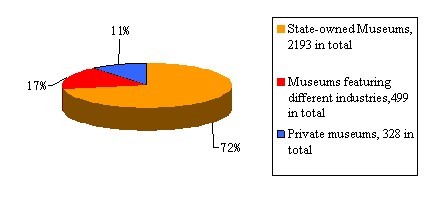- 中文
- EN
- Français
- 日本語
- 한국어
- 繁體中文
The Memory Treasured in Countryside Museums: “People Have Their Roots There”
The Composition of Museums in China
(At the end of 2009)

There are 3020 museums in China at the end of 2009.
700 more museums were added at the end of the Tenth Five-year Plan.
The number in total is 143.8 times more than that in 1949.
The number in total is 8.65 times more than that in 1978.
Since 2008, the number of exhibitions held annually reaches 10,000, with the number of audience up to 400 million.
There are 1743 museums, memorial halls and educational centers for nurturing patriotism opening free to the public, with an increase up to 50% in the number of audience compared with that before the free admission policy was adopted.
Every year, the Central Government allocates two billion yuan to museums.
Source of Date: State Administration of Cultural Heritage
May, 18th, International Museum Day
Modern museum is a part of a nation’s social educational system. It is a public institution, which is its foremost feature. Museum breaks down the barrier to equality of educational opportunity. Education in the museum is an extension of that at home and school, which helps to increase people’s knowledge and nurture the sense of identity. A museum without the involvement of the public must have strayed from its original path. It is an undeniable fact that museum should be free to the public, or at least with a very cheap fare.
Free admission policy was adopted in China’s museums only three years ago. Due to its enormous significance, it will be written in one chapter of the Chinese cultural history. Only after more and more people pay visits to the museum can the museum awareness of the public be enhanced.
It is very pleasant to know that the last three years has witnessed more and more people visiting museums with the museum’s popularity among both highbrows and lowbrows increasing day by day. It is particularly noticeable that some people in the countryside volunteer to build museums, in order to store the memory. Though these countryside museums are in their primary stage, they reflect the trend that museums are embracing the general public. It has shown that people’s museum awareness is enhanced. Countryside museums are the fruit of the construction of new countryside culture, demonstrating the change of a rural China into a modern China. While for the new generation of museums with Wenchuan Museum as their representative, they not only pass down national cultural heritage to future generations, but also actively become part of local people’s cultural life, which further demonstrates the cultural significance of the museum.
Since the theme of this year’s International Museum Day is “Museum and Memory”, a written tour into the countryside museums is provided to enable readers to explore that memory of the countryside deeply buried in the heart.
——The Editor
Museum of Folk Art at Nanzhanglou Village, Qingzhou City, Shandong Province

“People Have Their Roots There”
Reporter: Liu Chengyou
Nine years ago, a museum of folk art was established in a village named Nanzhanglou, which is about 20 km from and northeast to Qingzhou city, Shandong province.
Museum located in a village is destined to be lonely. However, Yuan Chongwu, the gatekeeper aged 68 said, “During the first few years after the establishment, it was not necessary to open the door everyday, only few times a week. But things have changed in recent two years as more and more people come to visit the museum”.
500 treasures broaden visitors’ horizon
There are over 500 pieces of countryside “cultural relics”, which broaden visitors’ horizon. Most of these objects are collected from the villagers and each is attached with a small tag showing the name of the donor. They are classified into four categories: farming tools used in the old days, daily necessities in the countryside, cultural goods in the countryside and articles used on weddings or funerals.
“It will be more difficult to find these tools in the next few years.”
Yuan Xiangsheng said that the purpose of building this museum of folk art was to let the young in this village learn about its history and the tough lives led by our ancestors, hence they would cherish the life today.
Yuan Xiangsheng had expressed his concern that “many farming tools are still available to build the museum now, such as water wheel, wooden plough, windmill, wooden loom and wooden straw rope making machine. But in the next few years, it will be pretty difficult to collect them.”
“People tend to settle down as they have seen such ‘visible’ roots.”
Students from nearby primary schools and middle schools came to visit the museum. The young students watched the objects with mixed feelings: a sense of familiarity and a sense of remoteness. Yuan Chongwu said that “it is very difficult for the young students to correctly name all the objects even though they grow up in the village. No matter what, they should learn about the lives led by the ancestors.”
When the museum was completed, the new person in charge of the project from Germany visited the museum with great interest and he wrote a comment in the guestbook, which read “there is a beautiful museum in such a beautiful village”. Another German expert also added a comment to the guestbook after visiting the museum, which read “people have their roots here and they tend to settle down as they have seen such ‘visible’ roots.”
Museum of Folk Art at Longya Village, Lingyun County, Guangxi.

The Spirit of Longduitun
Reporters: Pang Geping, Xie Jianwei
Museum of Longdui Folk Art was officially opened to the public on January 18, 2008. It boasts of nine galleries, covering an area of 100 square meters. There are over 200 objects on display, all of which are the farming tools and daily necessities used by the Han Chinese living in this highland in Lingyun County for different periods. A systemic map is clearly drawn about the history of Longduizhai. Visitors could feast their eyes on all the colorful folk art of Han Chinese living in this highland in Lingyun County
“In the past, there was no water, no electricity and no tarred road in Longya Village. Arable land was scare and shabby houses were built on stones with thatched roof. One had to walk 10km in the mountains to fetch water… ” said Wu Tianlai, curator of the museum and Party leader in this village.
Nowadays, villagers prosper day by day and poverty and backwardness of the past is treasured in today’s historical museum. They collected the farming tools and daily necessities used in the past and volunteered to build this museum of folk art. In a very conspicuous place hangs a board, with eight Chinese characters engraved on it, which read “In order to survive, never give up” – the very spirit of Longdui people.
“Not all the ‘homely treasures’ collected by the Museum of Longya Folk Art are priceless, but each object is attached with an inspirational story, the value of which could not be rivaled,” said Wu Tianlai.
Museum of the Red Memory in Xiaohemiao Village, Xianyang City, Shannxi.

Rekindle the Memory of the Red – Love for the Red Army
Reporter: Yang Yan
The museum is divided into two parts, one is the front courtyard and the other is the back courtyard. In the gallery, there are many photos and paintings hanging on the wall. Various documents are on display in the showcases. What’s more, various ceramics, short-legged tables used on a heated brick bed, spinning wheels, currency used in the Red Region and so on, with distinctive features of their times are on display. This has vividly demonstrated the history of the Communist Party of China from the Long March to the Reign in Yan’an and until the Construction of Socialism.
Wei Dejun, a man aged 50 and born in Xiaohemiao village, started to build his own business in 1998. Museum of the Red Memory, with a total investment of almost 2 million yuan solely from Wei Dejun, was officially open to the public on July 1st, 2008. Up until now, it has received over 30,000 visitors free of charge.
“Many people do not understand why I would do this, but I think it is worthwhile!” said Mr. Wei in 2002 when he was donating money to dig a well for villages in Xiaohemiao village. After this project, Mr. Weil felt that some villagers were rather selfish and full of musty old ideas. Therefore, he came up with the idea of building a historical museum featuring the revolution of the Red Army, so that the fine style of work and noble spirits could be passed down.
Today, this Museum of Red Memory boasts of three galleries, with the total number of objects exceeding 10,000. It has become the educational centre for nurturing patriotism in Xianyang City. “For me, everything has just started. But I firmly believe that the Museum of Red Memory, which is still in its infancy, will have a promising future…” said Mr. Wei.
Wenchuan Museum in Sichuan Province

Beyond Cultural Heritage and Memory
Reporter: Yang Xuemei
Wenchuan Museum in Sichuan Province was officially open to the public on the morning of May 12th.
For Memory
“That disaster should never be forgotten”
The whole complex forms the shape of English letter “T”. The tall watchtower between two buildings is very conspicuous. It is built according to the craftsmanship of the Qiang ethnic group. The dark cyan stones denote a sense of graveness. The main body of the museum is covered with aluminum sheets with the color of red, which is the favorite color of Qiang ethnic group. Legend has it that the Qiang ethnic group is the offspring of Yan Emperor (a legendary Han Chinese ruler who lived in pre-dynastic China), also known as the Red Emperor. Therefore, they would display the color red everywhere on important occasions. Taking a few steps forward, visitors would find a wall made of blue stones, with five big Chinese characters on it, which read “Wenchuan Museum”.
There are two stone tablets, both engraved with a passage related to the establishment of this museum. The name of the designer of this museum is also engraved on the stone tablet – He Jingtang, also the designer of the China Pavilion in Expo 2010. After several drafts, He Jingtang and his team finally came up with this design – a vast complex integrating museum, cultural hall and library. This is the larges cultural project funded by Guangdong province. Covering an area of 7949.8 square meters and with building area reaching 9071 square meters, this project cost about 6.46 million yuan.
“Before the earthquake, there was only a small gallery with an area of about 100 square meters in the whole county. Thousands of cultural relics had to be stored in the storage, beyond the reach of the general public,” said Luo Jinyong with great optimism, director of Wenchuan Country Administration of Cultural Heritage and deputy director of the museum. “Things have improved a lot. There are now two museum in Wenchuan County, one of which is Whenchuan Museum featuring the history of Qiang ethnic group. An earthquake museum is under construction in Yingxiu. Except those sites which could not be moved to the museum, all cultural relics we have collected will be placed in the new earthquake museum, the number of which has already exceeded 10,000. Chinese people would never forget this disaster. ”
Beyond Storing the Memory
“The cultural landmark is being integrated into people’s daily lives”
Now, Wenchuan museum opens free to the public, at 9:00 AM and closes at 4:30 PM. “According to the original plan, museum should be closed on Monday for maintenance. However, since the trial period, it has been open to the public on a daily bases. Up to now, booking in advance or lining up for tickets have not been adopted and visitor are welcome once they come here. Everyday, it receives about 3,000 visitors.” Luo Yongjian spoke slowly after his logical thinking.
Taking a few steps to the east of the museum, visitors would find the newly built Workers’ Cultural Hall. While to the west of the museum is Guozhuang Square where people can dance and a huge film screen is erected. Opposite to the square is the Xiqiang Cultural Street. A few steps further would unveil the Youth Cultural Square.
It is very obvious that Wenchuan Museum is not only for passing down the cultural heritage or storing memory, but also is being integrated into people’s daily lives. Maybe one day, these new cultural landmarks would become the topic for people to chat in leisure time, or even take their presence in children’s diaries: “Today, I have visited Wenchuan Museum…”
Background Information:
A museum is a non-profit, permanent institution in the service of society and its development, open to the public, which acquires, conserves, researches, communicates and exhibits the tangible and intangible heritage of humanity and its environment for the purposes of education, study and enjoyment.
The International Council of Museums was established in Paris, France in October, 1946. Since 1977, The International Council of Museums has adopted May 18th as the International Museum Day. On this day, museums around the globe would hold various activities to let people know more about museums and better exert their social functions. The International Museum Day in 2010 set a new record, with 30,000 museums from 95 countries taking part in the celebration.
The theme of this year’s International Museum Day puts emphasis on the following aspects. Museum stores the memory of civilization, passes down cultural heritage and foster innovation. It is a bond, integrating the past, present and the future. Museum should take full advantage of its collections of cultural relics, motivate the general public to explore and discover the memory in the past and preserve the rare and delicate cultural heritage of mankind.
(From Xinhua News Agency)



